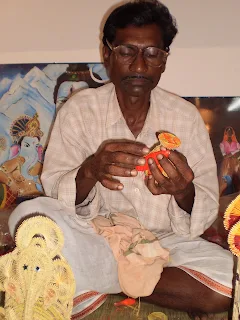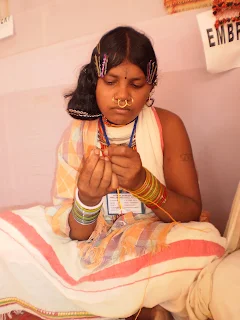Banita Behera
IGRMS,Bhopal
While looking at craft an obvious question arises out
of curiosity which sometime remains unanswered. Question possibly may be how
this thing came in-to existence? How this thing was made and who made it? The
indigenous tribal people of India along with their culturally rooted aesthetic
principles and associated moral and religious values emphasize their craft as a
unique one. As an innate and inseparable part of culture and society, the art
and craft produced is styled in culturally patterned ways. There are many
traditional art and crafts of tribal people, which are now on the verge of
extinction. It is need of the hour to preserve and revive their culture which
is gradually decoying. A Whole hearted effort is to be made by adopting
various measures and technologies to preserve and revive it or else this great
cultural tradition will be buried under the sandy-shore of time. The income
generating activities should not cause the tribals to migrate to urban centers
where the urban infrastructures has no space for these people, nor does the
caste-bound society gives any social respect to them. Craft demonstration,
craft mela, tribal artist camp are such unique programmes which are now
promoted by both govt. and non-governmental organizations to promote the craftsmanship along with their craft. The aim of such programme is to uplift the tribal who have been facing acute poverty, land alienation problems, lack of livelihood opportunities, food insecurity, health problems etc and to bring the tribal artisans on a par with the general population. The art and craft of the tribal are extremely gratifying in the most contemporary artistic sense where tribal art steps out of the pure and confirmed ritual sphere to give voice to concerns such as urban encroachment, violence participated by the state and the influence of modern technology. some of the tribal art and crafts need some exposure in the global market for the sustainability. following are the example of some tribal arts and crafts.
Tribal Painting
Since time immemorial the available valuable remaining graphical drawings and paintings designed by man in prehistoric caves and rock shelters depicts the human expression of thought and thinking. Painting among the tribal people are the virtual showcases accentuating their ritualized lives, customs and tradition. Among the Saora tribes of Odisha wall painting is a sacred enclosure to pay respect to their ancestral sprits God and Goddesses, Whereas the Warli painting is a common practice among the Warli community of Maharashtra during auspicious times like wedding and installation of their deity etc. Traditionally the concept of paintings among the tribal communities was only a partial activity of the specific persons of their communities. But now because of great value of such paintings these genuine talents are replaced to common one by commercial substitutes.
 |
| The Lanjia Saora painters |
 |
| A Rathwa painter |
 |
| The Bhill painters |
Siali fiber craft of Mankidia
The Birhors of Jharkhand Popularly known as Mankidia tribe in Odisha.
These primitive people are very fine craft makers. They use locally
available siali creepers as raw material which is abundant throughout the year.
These forest people, by collecting
Siali fiber/creeper from nearly forest, process it and make various carrying
net, monkey catching traps, oil extractor basket, cow ropes, bags etc for
various utility.
 |
| The siali craft of Mankidia |
Paddy craft of Bhottara
The paddy craft made by the Bhottara tribe of Odisha is a well renowned
craft of Odisha. The Bhottaras by carefully knitting the each piece of
un-husked paddy to the next with different colored thread into a fine split of
bamboo and make chains to prepare small figures of Goddess Laxmi, Goddess
Saraswati, Lord Jagannath, Lord Balabhadra, Goddess Subhadra, Lord Hanuman,
Goddess Durga and Lord Vishnu. Besides, they have also show their mastery over
the craft by making the several decorative things according to the market
demand.
 |
| A Bhottara artist doing paddy craft |
 |
| A Bhottara woman with her paddy crafts |
Embroidery work:
Since living in a close harmonious nature the
tribal have developed a natural art with them. Embroidery work of the tribal
communities is such an art where we can find a theme in the colors and designs
directly resembles. With the help of sharp needle work, the Dongria Kondh women
and Toda women shows their extremely good skill in embroidery which is a
pattern of their aesthetic sense and nature influenced.
 |
| Dongria Kondh lady doing embroidery |
 |
| Dongria kondh girl doing embroidery |
Traditional weaving:
Weaving tradition among the tribal people is an indispensible work of
women in their social life. In Manipur a girl without the knowledge of weaving
is considered to be immature to attain a married life, whereas the weaving of
Ringa (loin cloth of women) among the Bonda tribe of Odisha bears a mythical
value behind it. It is because of these great traditions that the tribal and
folk people of Manipur and Bonda of Odisha are well identified with their
unique dress, color, and patterns. Weaving in every household of Manipur is
prepared with the help of simple strap-loom , whereas the Bonda tribe practice
it with the help of a pit-loom.
 |
| A Bonda woman weaving Ringa in a pit-loom |
 |
| A Kom women with her strap-loom |
Being a National museum of Mankind IGRMS is sporadically organizing such type of craft mela, demonstration programmes in different states to make alive the different culturally vibrant crafts which are on the brink of evaporation. 'The National Live Demonstration Programme on Tribal arts and crafts' at Bhubaneswar which was held from 1st-10th June 2012 for 10 days in the complex of Museum of tribal Arts and Crafts, Bhubaneswar, was the first attempt of IGRMS to introduce the inter-state craft making techniques of other tribal communities among the Odisha tribes collaboratively with SCSTRTI, Bhubaneswar.
Around 32 artists from different tribal communities and states except Odisha were invited by IGRMS, Bhopal having artistic skill on different craft. Gond and Bhill painters from Madhya Pradesh, Rathwa painters from Gujarat, Kotta craft artisans from Tamil Nadu, basket weavers from Manipur, Muria painters from Bastar, Weavers from Manipur, and Toda embroidery artisans from Tamil Nadu participated in the demonstration programme to show the mastery over their concerned craft.
These artisans were invited with an apparent motive
to encourage their economic activity through a collective mode by creating
integrated links. Each of the tribal artisans has their great importance with
nature and culture, and their habits are really humble and affable in such a
way to be appreciated. The weavers from Manipur, one among them enthralled the
visitor with all of their beautiful traditional weaving techniques.
The sharing of ideas and enormous interests of the
artisans to learn and to share their own ideas and techniques with other
communities is the unusual achieved output of this programme. The Interactive
session was also organised where participants interacted with the resource
persons invited by the co-organizers. This collaborative exercise has given
them full support to demonstrate their skills of craftsmanship by using locally
available materials and input of the innovative ideas through mutual
interactions.
 |
| Maring artists learning paddy craft |
 |
| A paite artist learning siali craft |
 |
| A Paite artist learning bead knitting. |
To create a sustainable atmosphere for these diminishing craft and culture a chain should be developed between the artisans and the global market through the government or non-government organization with minimized or no mediators resulting in profitable transactions. This session stressed on the need for promotion of tribal art and crafts and their sustainable development.
*Based on the research work of the author
Comments
-Arabinda Routray